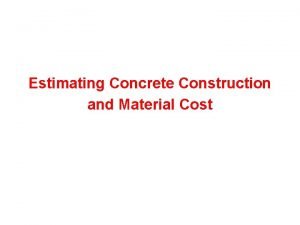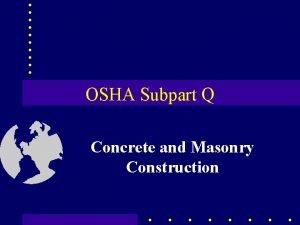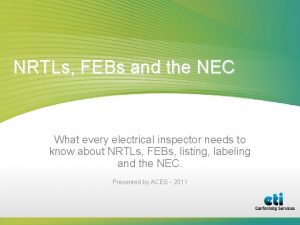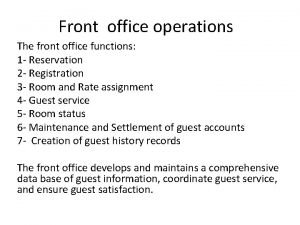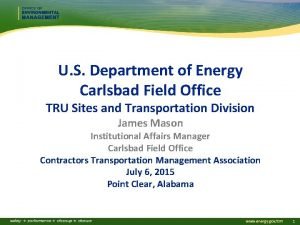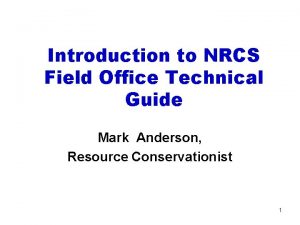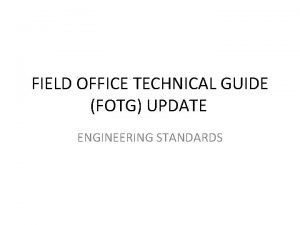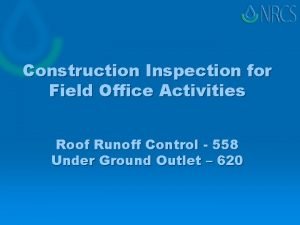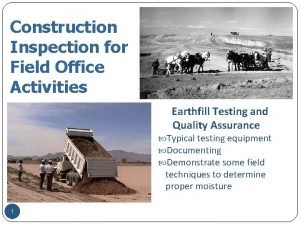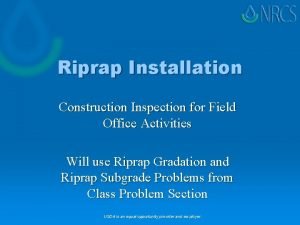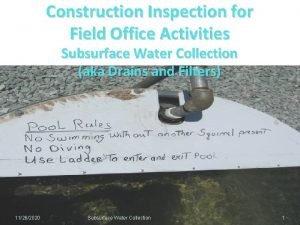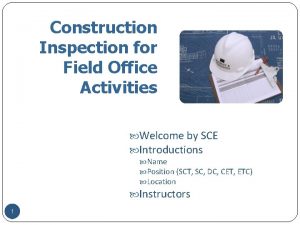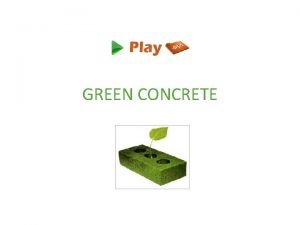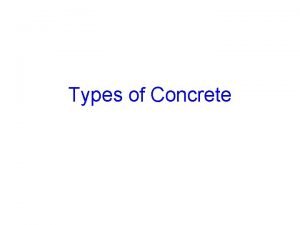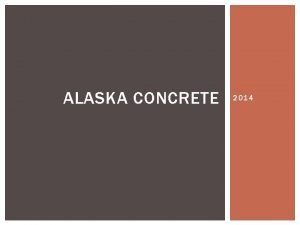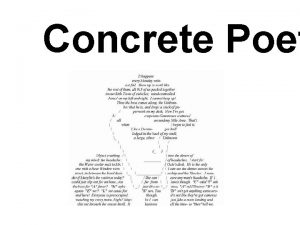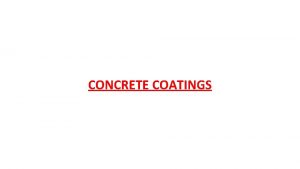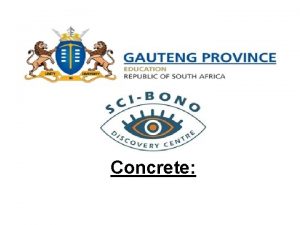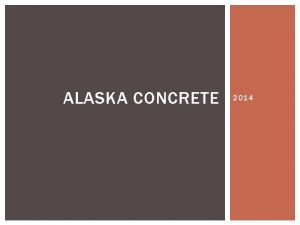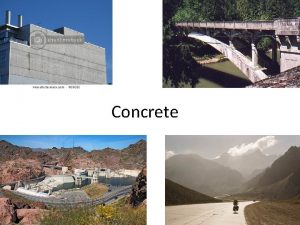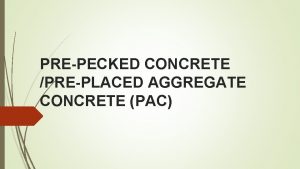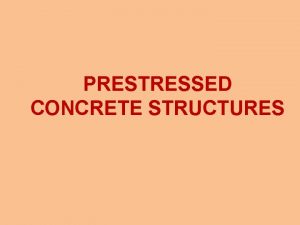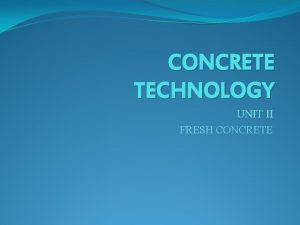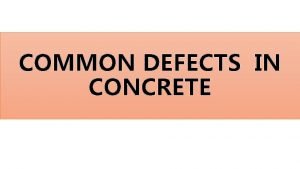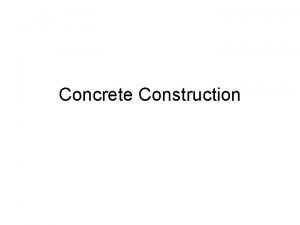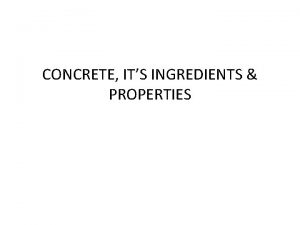Concrete Inspection Construction Inspection for Field Office Activities















































- Slides: 47

Concrete Inspection Construction Inspection for Field Office Activities

Objectives • Review and define terms related to quality concrete • Review typical specification requirements • Discuss testing procedures and results based on specification

Terms Related to Quality Concrete • Durability – Long lasting • Permeability – Ability to hold fluids • Water to cement ratio (w: c) – Affects durability and permeability – Low w: c results in higher durability and lower permeability (Good) – Determined from weight of total water in the mix (includes water in aggregates) divided by total weight of cement-like material (cement and fly ash)

Terms Related to Quality Concrete • Slump – Measure of workability • Air – Amount of entrained air in mix • Compressive Strength – Strength of design mix or actual specimens after 28 -day curing period • Curing – Time period when exposed concrete surfaces are not allowed to be dry

Concrete Specifications and Testing Review the concrete specification in the Mortality Facility Example Plans • Compressive Strength – 4000 psi at 28 days • Water to cement ratio – 0. 50 • Air Content – 5 -8 percent • Slump – 3 -5 inches • Curing – 7 days without drying • Temperature – 40 -90 degrees F What testing is required?

Concrete Class Problem Found in Class Problems Section. Refer to Happy Hogmeister Mortality Facility Design packet to answer questions 1 -4 at your tables. The specification in the mortality facility example requires a w: c of 0. 50 or less. 1. Does the design mix meet the specification?

Concrete Class Problem 2. What is w: c of batch? Weight of water = 242 gal x 8. 33 lb/gal = 2024 lbs Weight of cement = 5076 w: c = 2024/5076 = 0. 399 3. Can water be added? 4. If water is added how many revs required?

Concrete Class Problem 3. How many gallons of water can be added? Max water weight = 0. 45 x 5076 = 2284 lbs Max water gallons = 2284/8. 33 = 274 gallons Additional gallons = 274 -242 = 32 gallons

Steel Reinforcement for Concrete Construction Inspection for Field Office Activities

Objectives - Develop an Understanding Of: • • The purpose and use of steel reinforcement The materials used for steel reinforcement The placing of steel reinforcement The tolerances for placement of steel reinf

Basic Principals • Concrete is strong in compression and shear strength • Concrete is weak in tensile strength Compressive strength 4000 psi Shear strength @ 80% ~ 3200 psi Tensile strength @ 10% ~ 400 psi

• Steel is strong in compressive, tensile and shear strength • Structural grade steel: – Tensile strength ~ 18, 000 psi – Compressive strength ~ 90, 000 psi • Steel bars in compression tend to buckle • Will not support substantial compressive loads alone

• Concrete bonds well with steel • Both have nearly the same coefficient of expansion – 1 inch per 100 feet between winter and summer • Concrete and steel stick together and act, together, to make reinforced concrete • R/C is strong in both: – Compression, and – Tension

Main Tensile Reinforcement • Loaded beam supported at each end tends to sag


• Convex bottom of beam is in tension • Concave top is in compression • Without steel reinforcement near the bottom of the beam the concrete cannot withstand the tension Wooden Craft Sticks Demonstration!!

Temperature and Shrinkage Reinforcement ( T & S) • Temperature changes can cause – Expansion, or – Contraction • Shrinkage causes contraction • Expansion induces compressive forces in concrete & is not normally a problem • Contraction induces tension which must be counteracted

T & S Reinforcement (cont) • Steel bars used for contraction reinforcement are usually #3 or #4 bars spaced 12” to 18” apart with cross bars as needed for tying • Some concrete is reinforced (for T&S) with steel or plastic fibers added to the concrete during mixing

Reinforcement Location in Typical Sections • Location of structural steel reinforcement is crucial to the construction of any concrete structure • Steel placed near the center of a wall is usually T & S reinforcement unless it goes into a foundation, wall base, or floor

Reinforcement Location in Typical Sections • Tension is greater on the surface opposite of the forces (earth or stored material) • Steel reinforcement for tension needs to be placed as close to the tension surface as possible • There is a minimum cover to maintain to protect steel from corrosion & to insure adequate bond of concrete to steel

Materials • Bar Reinforcing Steel – Smooth - used for dowels – Deformed – the standard type of reinforcement • Protrusions or deformation conform to ASTM A 615 • Concrete bond with the steel is dependent on deformation

• Three grades of steel – Stuctural 40, 000 psi Grade 40 – Intermediate 60, 000 psi Grade 60 – Hard 75, 000 psi Grade 75 • Bar sizes from #2 (smooth) to #18 • Nominal diameter of bar = bar size/8 – #4 bar = 4/8 or ½ inch diameter

(From ASTM A 615)

How to Read Bar Markings

How to Read Bar Markings

How to Read Bar Markings

Example Rebar 1 extra rib = Grade 60 Producing Mill # 4 bar = ½” S = Billet (ASTM A 615)

Example Rebar Grade 60 Producing Mill # 5 bar =5/8” S = Billet (ASTM A 615)

Welded Wire Reinforcement (WWR) • Rolls – Difficult to flatten and position correctly – May be used for slabs on grade • Sheets – Delivered in flat sheets – Easier to position correctly – Heavier gauges available

WWR Example of poor positioning in slab

WWR continued • WWR generally comes in 6, 8 or 10 gage wire • Rectangular grid pattern - 6” by 6” is most common

Typical Bar Types

Placing • Surface condition of steel – no loose, flaky, scaly rust – Light covering of tight, yellow brown rust is beneficial in increasing the adhesion of concrete to steel – Remove oil from re-bars if excessive – Remove any mud from bars • Reinforcement - accurately positioned and secured as shown on the drawings

Placing - continued • Supports should hold bars firmly – Sufficient strength to carry the loads – Not displace too much concrete – Eliminate any opportunity for leakage or rusting – Close enough together that bars will not sag appreciably

Placing – Examples of supports

Placing – Examples of supports

Placing – Examples of supports

Placing – Examples of supports

Placing - continued • Splices – dependent upon – Bar diameter – Location in structural member – Location to other laps • Splice location typically not shown on the drawings • No lap length less than 12 inches – Typical lap = 30 D (D = bar diameter)

Cover • Construction Plans will show min cover • Cover = distance between concrete edge and reinforcing edge or between rebar edges • Typical cover distances – #4 bars in footings, ends exposed to earth = 3” – #4 bars, slab, exposed to earth or weather = 2”

Example Tolerances (Location) • Minimum cover shown on drawings: ± 3/8” • Location in wall or floor section: ± 3/8” of position shown on drawings • Lap or splice location: ± 1”, minimum splice length of 12” From NEH 645, Appendix E

Example Tolerances (Spacing) • Minimum spacing shown on drawings: ± 1/4” • Uniform spacing shown: ± 2” from theoretical location From NEH 645, Appendix E

Tolerances for Placement

Interpreting Steel Drawings Refer to composter drawings sheet 4

Interpreting Steel Drawings

Interpreting Steel Drawings

Review Questions (Use sheet 4 of the Composter drawings to answer) 1. 2. 3. 4. 5. What shape is a type 21 bar? What shape is a Mark W 2 bar? What is the spacing for the Mark W 4 bars? What is the tolerance for that spacing? What is the nominal diameter for the Mark W 4 bars?
 Informal inventory
Informal inventory Concrete semi concrete abstract
Concrete semi concrete abstract Absolute volume formula
Absolute volume formula Osha 1926 subpart q
Osha 1926 subpart q Nrtl field inspection
Nrtl field inspection The statement of cash flows helps users
The statement of cash flows helps users Indoor and outdoor sports list
Indoor and outdoor sports list Support activities and primary activities
Support activities and primary activities Primary activities and secondary activities
Primary activities and secondary activities Magnitude of magnetic force
Magnitude of magnetic force Individual differences in second language learning
Individual differences in second language learning Field dependent vs field independent
Field dependent vs field independent Electric field and magnetic field difference
Electric field and magnetic field difference E field h field
E field h field Data types and field properties
Data types and field properties Field dependent and field independent
Field dependent and field independent Difference between electric field and magnetic field
Difference between electric field and magnetic field Front office work shift
Front office work shift Carlsbad field office
Carlsbad field office Field office technical guide
Field office technical guide Field office technical guide
Field office technical guide Fspos
Fspos Novell typiska drag
Novell typiska drag Tack för att ni lyssnade bild
Tack för att ni lyssnade bild Ekologiskt fotavtryck
Ekologiskt fotavtryck Varför kallas perioden 1918-1939 för mellankrigstiden?
Varför kallas perioden 1918-1939 för mellankrigstiden? En lathund för arbete med kontinuitetshantering
En lathund för arbete med kontinuitetshantering Underlag för särskild löneskatt på pensionskostnader
Underlag för särskild löneskatt på pensionskostnader Tidböcker
Tidböcker Sura för anatom
Sura för anatom Vad är densitet
Vad är densitet Datorkunskap för nybörjare
Datorkunskap för nybörjare Tack för att ni lyssnade bild
Tack för att ni lyssnade bild Mall för debattartikel
Mall för debattartikel Autokratiskt ledarskap
Autokratiskt ledarskap Nyckelkompetenser för livslångt lärande
Nyckelkompetenser för livslångt lärande Påbyggnader för flakfordon
Påbyggnader för flakfordon Lufttryck formel
Lufttryck formel Publik sektor
Publik sektor Lyckans minut erik lindorm analys
Lyckans minut erik lindorm analys Presentera för publik crossboss
Presentera för publik crossboss Argument för teckenspråk som minoritetsspråk
Argument för teckenspråk som minoritetsspråk Kanaans land
Kanaans land Klassificeringsstruktur för kommunala verksamheter
Klassificeringsstruktur för kommunala verksamheter Mjälthilus
Mjälthilus Claes martinsson
Claes martinsson Centrum för kunskap och säkerhet
Centrum för kunskap och säkerhet Programskede byggprocessen
Programskede byggprocessen


